In invertebrate aquariums and aquascaping in general, bee shrimp and others from the streams of Hong Kong are popular as algae eaters and colour spots. They hail from biotopes with extremely clean water - in running waters they basically have a 100% water change every second. Even fish from rivers with black water live in a very low germ density. They are not used to pollutant accumulations and high germ densities and their immune system is therefore not adapted to them. In the aquarium, on the other hand, we sometimes have an enormously high bacterial count, in practically every case it is higher than in the natural biotopes of these aquarium animals.
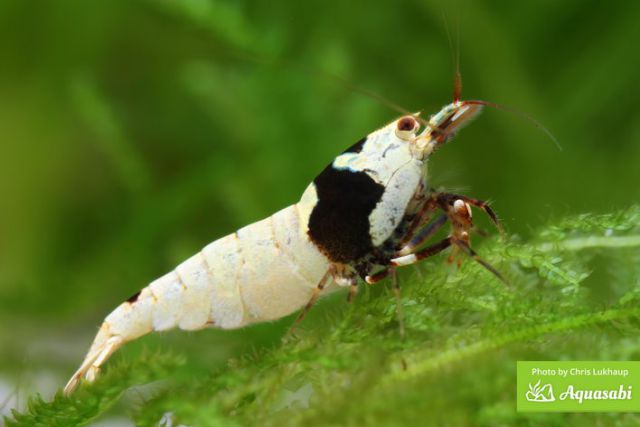
Especially in shrimp aquariums a high bacterial count can be problematic, it can weaken the shrimp's rudimentary immune system and make them susceptible to bacterial infections by bacteria, viruses, fungi or parasites. We have an article in the Aquascaping Wiki covering the problem of mounting parasites and dwarf shrimp: "Shrimp parasites and commensals in the aquarium". Distoma or parasitic algae in particular are weakening parasites that take advantage of an immune system that's been brought to its knees and then take over. If such problems occur, one should always consider a possible bacterial load in the aquarium and take the necessary measures, which we explain below.
Reasons for a high bacterial load in the aquarium
A high number of bacteria in the aquarium is always due to the presence of an abundance of nutrients. No reproduction without food! Bacteria can multiply enormously fast - in "optimal" conditions some species can double the population within 20 minutes. Bacterial growth is divided into four phases:
-
Lag phase: Here the bacteria adapt to the conditions, the bacterial count is low.
-
Log- or exponential phase: Cell division starts, the number of bacteria rises sharply.
-
Stationary phase: The bacterial populations reach the limits of their capacity, their further growth is limited by the scarcity of nutrients or the limited space available.
-
Death phase: The bacteria starve or die of excretion products, the bacterial population decreases again.
Reducing the germ count
There are many different means and methods in aquaristics of reducing the bacterial count in aquarium water. We will deal with the most common ones below.
UV-C-Sterilizer
In short, water is pumped through a UV-C sterilizer and irradiated with the aid of a UV lamp. The UV-C light in the UV burner causes bacteria and algae spores in the water to die.

How a UV-C-Sterilizer works and what you should keep in mind when using it is explained in detail in our Wiki article "UV-C-Sterilizer in the aquarium".
Aktive Oxygen
Active oxygen consists of oxygen radicals that are very reactive and therefore attack and destroy bacteria (and algae spores). There are different methods of introducing active oxygen into the aquarium. The two most common are on the one hand with the help of a Söchting Oxydator, which produces oxygen and oxygen radicals from hydrogen peroxide with the help of a catalyst, and on the other hand this can be done by electrolysis. Electrolytic processes for the production of active oxygen are particularly popular in the waste water industry, and with the Twinstar this is now also possible in the aquarium in a very simple way.
![Twinstar Sterilizer]()
How to use these state-of-the-art sterilizers and what to look out for is explained in our Wiki article "Twinstar", frequently asked questions are answered in the article "Twinstar FAQ"..
Water change
A water change is a very proven and fast acting way to reduce the germ- and nutrient density of the water quickly. We generally recommend a water change of 50% per week so that nutrients cannot accumulate in the first place. With already existing problems, however, a water change of up to 80% is not problematic at all.

In shrimp aquariums, however, care should be taken to ensure that the fresh water has the same parameters of total hardness, carbonate hardness and temperature as the aquarium water so that the animals do not suffer an osmotic shock.
Humic substances
Humic substances have been actively used in aquaristics for many years against infections and a too high germ density and are introduced in the form of Alder cones or Catappa leaves. Meanwhile, however, preparations have become available that can be used to dose humic substances much more easily, accurately and conveniently - for example the "Liquid Humin Plus" from GlasGarten. In nature, humic substances can be found in almost every body of water, and waters containing humic substances in particular stand out due to their extremely low germ density. Humic substances interfere with the metabolism of harmful bacteria and prevent them from multiplying. These and other effects of these extremely helpful substances are discussed in more detail in the Wiki article "Humic substances in the aquarium".

Depending on the concentration, humic substances can turn the water brownish - but there are indications that even a small amount, which cannot even be perceived with the naked eye - has a helpful effect on germ density and the aquarium's inhabitants. To remedy an acutely high germ density, however, one should first dose the humic substances a little higher and aim for the the upper limit of the dosage instructions. For permanent use and prevention the dose can be heavily reduced.
Prevention - how to keep germ density low in the first place
Amount and quality of the feed
Not only the amount of food determines the presence of nutrients in the aquarium, but also its quality. If it is not easily digestible, fish and invertebrates excrete unused nutrients with their faeces, which in turn increase the bacterial load. In principle attention should be paid to the fact that as few as possible "fillers" are used in the feed, and keep an eye on high-quality products. A rough guideline for the amount of food is: Fish should have eaten flakes, granules and the like completely within 2-3 minutes, greenstuffs, pumpkin chips and suchlike, which are popularly used as shrimp and snailfood, shouldn't spend longer than a few hours inside the aquarium tank. Uneaten feed benefits bacterial growth and increases the bacterial load. Fresh food is particularly critical here - cucumber, which sometimes contains quite a lot of sugar, is particularly notorious and may - depending on tank size and dosage - cause whopping bacterial blooms.
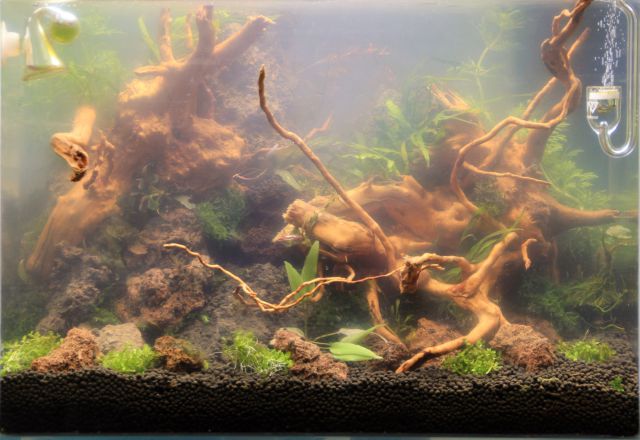
Under no circumstances should fresh food be left overnight in the aquarium (especially in the nanoaquarium) - even if this is often done recklessly. A then occurring bacterial bloom can cause a serious lack of oxygen and harm the aquarium inhabitants permanently - up to suffocation.
Water change
Not only for the immediate remedy of a high bacterial count in the aquarium, but also for prevention the water change is a suitable remedy. It replaces the water exchange in natural biotopes and simply drains excess nutrients and germs. Usually a weekly water change of 10-50% with water adapted to the values is recommended, whereby we gladly recommend 50% for well fertilized plant aquariums and aquascapes, so that nutrient peaks cannot form in the first place.
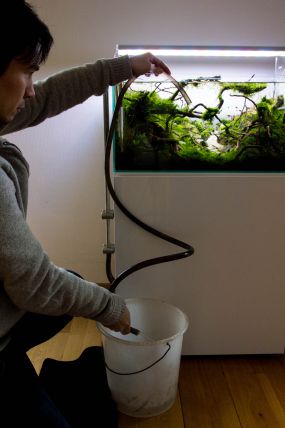
Substrate care and maintenance
Shrimp and other crustaceans in particular can produce a lot of food leftovers during feeding, which seep between the gaps and are just what the bacteria were waiting for. Apart from a feeding dish (explained in our Wiki article ), the regular siphoning of the substrate with a Siphon cleaner or Gravel cleaner is helpful.
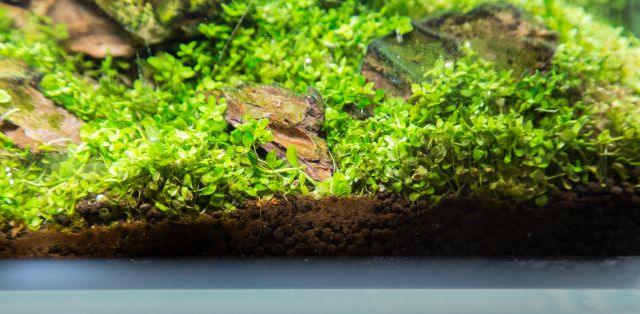
In addition, Malaysian trumpet snails have proven their worth as a cleaning troop in the substrate against feed particles. Caution: With a dense planting in the foreground, plants can become detached during substrate maintenance. Here we definitely recommend the use of feeding dishes if shrimp are to be kept in such a layout.
Filter
The filter bacteria are potent antagonists to harmful germs in the aquarium, and a well-functioning biological can therefore also ensure that the germ density in the aquarium water is low.
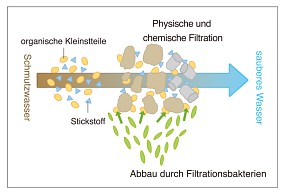
Copyright by Aqua Design Amano - ADA.
Since the filter bacteria are dependent on oxygen, you kill two birds with one stone using the Oxydator from Söchting - on the one hand you reduce the bacterial count in the open water and on the other hand you increase the oxygen supply in the aquarium. The Wiki article "Nitrogen cycle in the aquarium" explains exactly how the biological nitrogen cycle and thus the decomposition of pollutants in the aquarium water work..
Plants
The plants also play an important role in the nutrient utilization in the aquarium. They absorb nutrients from the water and produce oxygen, which in turn benefits the aquarium inhabitants and filter bacteria. Here it is important to avoid nutrient gaps (as explained in the article "Liebig's law of the minimum") and to ensure smooth metabolic processes in the plants.
![Aquarium]()
The how-to can be looked up in our Wiki article Let´s start with Q: Growing Aquatic Plants".
Special case: bacterial surface scum
A bacterial scum in the aquarium is also caused by high bacterial load, which makes itself noticeable directly at the water-surface. They can be recognized in the initial stage by oily streaks or - if it is already quite thick - by an opaque, membrane-like skin on the water surface. If you pass it with your finger or a fish net, it tears open and you can see the pieces.
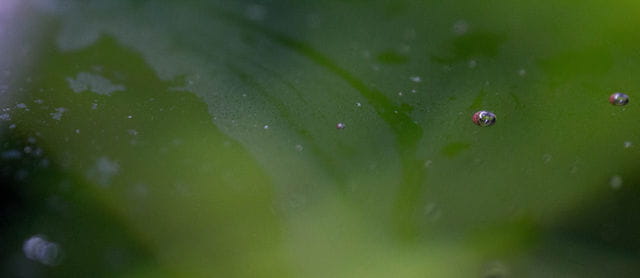
A bacterially caused film can also be permanently removed by containing the bacterial load in the aquarium. As an immediate measure, you can use a piece of kitchen roll, which is simply placed on the water surface, tech or surfaces and pulled off again. The Wiki article "Getting rid of surface scum" takes a closer look at the countermeasures available. In the long run, however, only a significant reduction of the nutrient density in the aquarium and an optimization of the nutrient uptake by the plants will help.